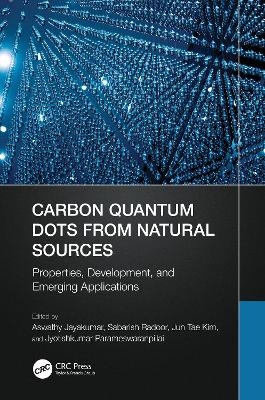
Carbon Quantum Dots from Natural Sources
CRC Press (Verlag)
978-1-032-56958-1 (ISBN)
- Noch nicht erschienen (ca. Februar 2025)
- Versandkostenfrei
- Auch auf Rechnung
- Artikel merken
Carbon quantum dots (CQDs) are a novel class of zero-dimensional carbon nanomaterials that are relatively nontoxic and cost-effective and offer desirable properties that make them excellent candidates for various applications. This book introduces the fundamentals of CQDs, natural sources and methods used for their synthesis, and characterization techniques. It addresses applications in biomedical, environmental, electrical, and other areas.
• Covers current research and future possibilities.
• Details modern fabrication methods and drawbacks.
• Discusses applications in biomedical use, wastewater treatment, electrical and electronics, dye removal, 3D printing, and metal detection.
• Provides insight into cytotoxicity and biocompatibility studies on these materials.
The detailed insight into these nanomaterials in this reference will benefit researchers, scientists, engineers, and advanced students in developing new methods and strategies in this advanced field of materials engineering.
Aswathy Jayakumar is a postdoctoral researcher at Kyung Hee University of Technology, Seoul, South Korea. She completed her Postdoctoral Fellowship at King Mongkut’s University of Technology, Thailand. She received her Ph.D. in Biotechnology from School of Biosciences, Mahatma Gandhi University, Kottayam, India. Sabarish Radoor received the Ph.D. (Chemistry) from National Institute of Technology, Calicut, India. He completed his Postdoctoral Research at King Mongkut’s University of Technology, Thailand. He is a postdoctoral fellow at Department of Polymer Nano Science and Technology, Jeonbuk National University, Republic of Korea. Jun Tae Kim is Associate Professor in the Department of Food and Nutrition, Kyung Hee University, Seoul, South Korea. He received his Ph.D. from Rutgers, The State University of New Jersey, USA, and worked as a Postdoctoral Research Associate at Cornell University. Jyotishkumar Parameswaranpillai is Associate Professor at Alliance University, Bangalore, India. He received his Ph.D. in Chemistry (Polymer Science and Technology) from Mahatma Gandhi University, Kottayam, India.
0. Front Matter. PART I. FUNDAMENTALS. 1. Introduction to carbon quantum dots. 2. Natural sources used to fabricate carbon quantum dots. 3. Methods employed for the development of carbon quantum dots. 4. Characterization techniques for carbon quantum dots. 5. Antimicrobial mechanisms exhibited by carbon quantum dots. PART II. APPLICATIONS. 6. Antioxidant properties and UV-blocking of carbon quantum dots in food packaging applications. 7. Anti-aging properties and utilization of carbon quantum dots in cosmetics. 8. Synergizing Carbon Quantum Dots for Biomedical Imaging, Targeted Drug Delivery and Photodynamic Therapy. 9. Carbon quantum dots for wound healing and wound dressing. 10. Carbon quantum dots for treating viral infections. 11. Carbon quantum dots and 3D printing technology. 12. Carbon quantum dots for bioimaging. 13. Cytotoxicity and Biocompatibility Analysis of Carbon Quantum Dots. 14. Application of carbon quantum dots in dye removal and wastewater treatment. 15. Application of carbon quantum dots in energy and electronic applications. 16. Carbon quantum dots for metal detection. 17. Environmental issues associated with carbon quantum dots.
| Erscheint lt. Verlag | 20.2.2025 |
|---|---|
| Zusatzinfo | 19 Tables, black and white; 7 Line drawings, black and white; 143 Halftones, black and white; 150 Illustrations, black and white |
| Verlagsort | London |
| Sprache | englisch |
| Maße | 156 x 234 mm |
| Themenwelt | Naturwissenschaften ► Biologie |
| Technik ► Elektrotechnik / Energietechnik | |
| Technik ► Maschinenbau | |
| Technik ► Umwelttechnik / Biotechnologie | |
| ISBN-10 | 1-032-56958-1 / 1032569581 |
| ISBN-13 | 978-1-032-56958-1 / 9781032569581 |
| Zustand | Neuware |
| Haben Sie eine Frage zum Produkt? |
aus dem Bereich


